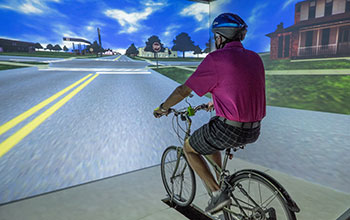Multimedia Gallery
Studying factors that put kids at risk when biking or walking (Image 1)
Researchers at the University of Iowa's (UI) College of Liberal Arts & Sciences are using a simulator they call the Hank Virtual Environments Lab to better understand the factors that put children at risk when crossing the street on a bike or on foot. In the simulation pictured here, they found that adults are able to take visual information and fine-tune their physical responses to it in ways children might not be able to match.
More about this image
The research is funded by the National Science Foundation's (NSF) Directorate for Social, Behavioral & Economic Sciences (grant BCS 12-51694) and development of the simulator is funded by NSF's Computer & Information Science & Engineering Directorate (grant CNS 13-05131).
In particular, Joe Kearney, the associate dean for research and infrastructure at UI, and Jodie Plumert, a psychology professor at UI who specializes in developmental science, want to learn more about the decision-making process children use when deciding when best to cross a street with the ultimate goal of giving parents information that could help them when they're discussing safety with young children.
The simulator allows them to perform the sort of experimental work that would be impossible in the field. Thanks to built-in, motion-tracking technology, the team can render the correct viewpoint for a person in real-time. When the person speeds up or turns, the virtual world immediately follows suit.
Most of the data the team has collected focus on children crossing the street on bicycles; for comparison, adults were also tested. Children in the 10- to 12-year-old range often are actually close to college students and older adults in terms of the gaps they deem safe to cross, but "their timing of movement is not as good as adults," Plumert said. "They delay when they start crossing, and as a result they actually have less time to spare before the next car comes."
The researchers are also using the simulator to gather information on walking, using even younger subjects, and have already produced some interesting results. All of the children tested in the 6- to 12-year age range timed their movements across the street poorly, when compared to adults. But while kids in the 6- to 8-year range tried to cross through some pretty risky gaps in traffic, the 12-year-olds were more conservative than either those younger subjects, or the adults. They waited for gaps so large that they crossed with as much time to spare as the adults, despite having poorer timing.
You can read more about this research in the NSF Discovery story Beyond looking both ways. (Date of Image: 2010-2015) [Image 1 of 4 related images. See Image 2.]
Credit: Hank Virtual Environments Laboratory at the University of Iowa
See other images like this on your iPhone or iPad download NSF Science Zone on the Apple App Store.
Images and other media in the National Science Foundation Multimedia Gallery are available for use in print and electronic material by NSF employees, members of the media, university staff, teachers and the general public. All media in the gallery are intended for personal, educational and nonprofit/non-commercial use only.
Images credited to the National Science Foundation, a federal agency, are in the public domain. The images were created by employees of the United States Government as part of their official duties or prepared by contractors as "works for hire" for NSF. You may freely use NSF-credited images and, at your discretion, credit NSF with a "Courtesy: National Science Foundation" notation.
Additional information about general usage can be found in Conditions.
Also Available:
Download the high-resolution JPG version of the image. (7.8 MB)
Use your mouse to right-click (Mac users may need to Ctrl-click) the link above and choose the option that will save the file or target to your computer.

